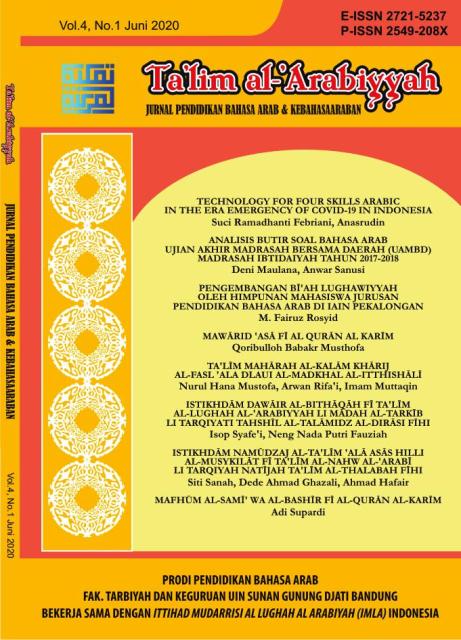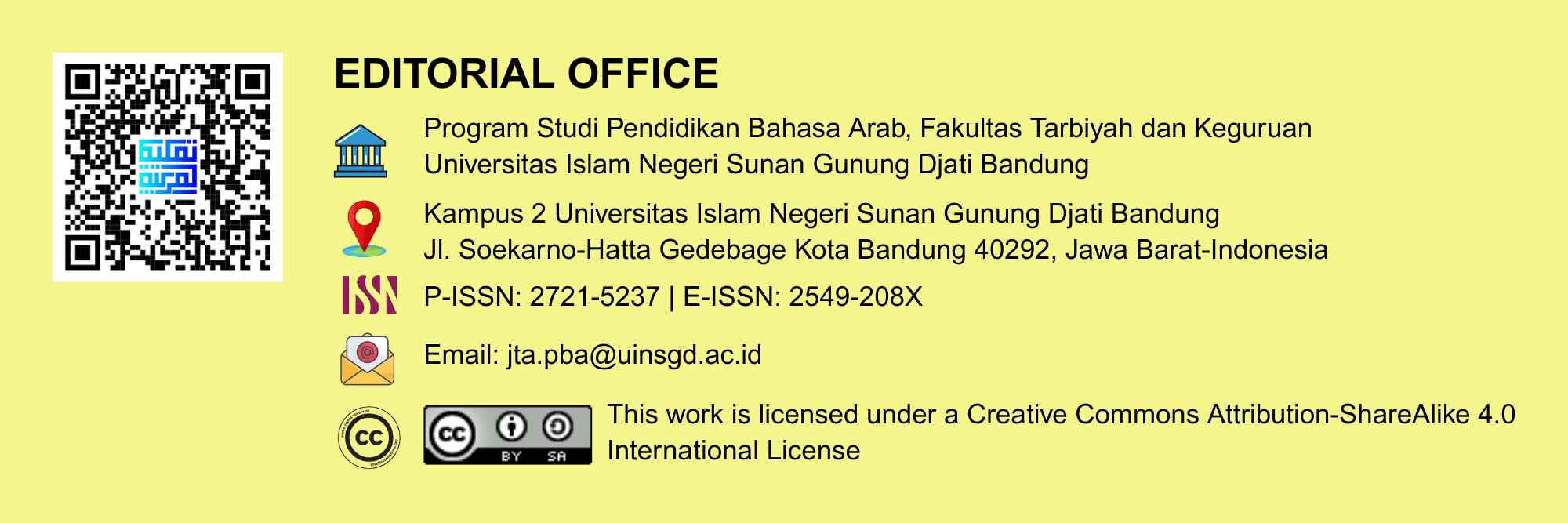TECHNOLOGY FOR FOUR SKILLS ARABIC IN THE ERA EMERGENCY OF COVID-19 IN INDONESIA
DOI:
https://doi.org/10.15575/jpba.v4i1.8221Abstract
The integration of technology and learning has become the primary key in developing various Arabic learning models in emergencies of the COVID-19 era. This study aims to describe and uncover the impact of technology on the learning process of Arabic on four Arabic language skills. This research uses a qualitative approach design utilizing the case study research method. Data obtained through observation techniques, interviews, and documentation with data analysis techniques using the theory of Milles and Huberman. The results revealed that the impact of technology on learning Arabic included several aspects of innovation in curriculum planning, implementation of learning, strategy development, and evaluation that varied online. The findings of this study are that the integration of technology with Arabic learning can improve creative and critical thinking processes and form a constructivist mindset. This study recommends that the use of appropriate technology for four language skills will affect Arabic learning outcomes to the maximum.
References
Ayunda Pininta. (2020, March). Bila Belajar di rumah diperpanjang: Tak harus Online dan Akademis. Kompas, p. 1.
Blake, R. (2016). Technology and the four skills. Language Learning and Technology, 20(2), 129–142.
Carrier, M., Damerow, R. M., & Bailey, K. M. (2017). Digital language learning and teaching: Research, theory, and practice. Digital Language Learning and Teaching: Research, Theory, and Practice, 22(1), 1–264. https://doi.org/10.4324/9781315523293
Carver, L. B. (2016). Teacher perception of barriers and benefits in K-12 technology usage. Turkish Online Journal of Educational Technology, 15(1), 110–116. https://doi.org/10.21125/inted.2016.1845
Davis, K., & Fullerton, S. (2016). Connected learning in and after school: Exploring technology's role in the learning experiences of diverse high school students. Information Society, 32(2), 98–116. https://doi.org/10.1080/01972243.2016.1130498
DoÄekal, V., & Tulinská, H. (2015). The Impact of Technology on Education Theory. Procedia - Social and Behavioral Sciences, 174, 3765–3771. https://doi.org/10.1016/j.sbspro.2015.01.1111
Freeman, I. M., Ed, D., & Ave, E. A. (2016). Life Skills for 21 st Century Learners. 3(10), 49–52.
Godwin, R. (2015). Emerging Technologies Contributing, Creating, Curating: Digital Literacies for Language Learners. Language Learning & Technology, 19(193), 8–20.
Griffiths, C., & Oxford, R. L. (2014). The twenty-first century landscape of language learning strategies: Introduction to this special issue. System, 43(1), 1–10. https://doi.org/10.1016/j.system.2013.12.009
Hembrough, T., & Jordan, J. (2020). Creating a digital writing classroom: A mixed methods study about a first-year composition tablet initiative. International Journal of Instruction, 13(2), 567–586. https://doi.org/10.29333/iji.2020.13239a
Hermawan, A. (2018). Pembelajaran Keterampilan Berbahasa Arab Dengan Pendekatan Komunikatif-Interaktif. Bandung: PT Remaja Rosakarya.
Huang, S. C. (2018). Language learning strategies in context. Language Learning Journal, 46(5), 647–659. https://doi.org/10.1080/09571736.2016.1186723
Kern, R. (2014). Technology as Pharmakon: The promise and perils of the internet for foreign language education. Modern Language Journal, 98(1), 340–357. https://doi.org/10.1111/j.1540-4781.2014.12065.x
Kılıçkaya, F. (2020). Learners' perceptions of collaborative digital graphic writing based on semantic mapping. Computer Assisted Language Learning, 33(1–2), 58–84. https://doi.org/10.1080/09588221.2018.1544912
Lai, C., Yeung, Y., & Hu, J. (2016). University student and teacher perceptions of teacher roles in promoting autonomous language learning with technology outside the classroom. Computer Assisted Language Learning, 29(4), 703–723. https://doi.org/10.1080/09588221.2015.1016441
Madrasah, D. K., Jenderal, D., Islam, P., Agama, K., & Indonesia, R. (2019). Keputusan Menteri Agama Tentang.
Marlina, D. (2019). Analisis Kemampuan Literasi Sains Pada Mahasiswa. 4(1), 9–18.
Musa, F., Mufti, N., Latiff, R. A., & Amin, M. M. (2012). Project-based Learning (PjBL): Inculcating Soft Skills in 21st Century Workplace. Procedia - Social and Behavioral Sciences, 59(2006), 565–573. https://doi.org/10.1016/j.sbspro.2012.09.315
Panagiotidis, P. (2018). Technology as a Motivational Factor in Foreign Language Learning. European Journal of Education, 1(3), 43. https://doi.org/10.26417/ejed.v1i3.p43-52
Portelli, J. P. (1994). The challenge for teaching for critical thinking. McGill Journal of Education, 29(2), 137–152.
Prakash, S., Singh, A., & Yadav, S. K. (2016). Personality ( Introvert , And Extrovert ) and Professional Commitment Effect among B . Ed Teacher Educator Students. The International Journal of Indian Psychology, 3(2).
Rusdin, N. M. (2018). Teachers' Readiness in Implementing 21st Century Learning. International Journal of Academic Research in Business and Social Sciences, 8(4), 1293–1306. https://doi.org/10.6007/ijarbss/v8-i4/4270
Teimourtash, M., & YazdaniMoghaddam, M. (2017). On the Plausibility of Bloom's Higher Order Thinking Strategies on Learner Autonomy: The Paradigm Shift. Asian-Pacific Journal of Second and Foreign Language Education, 2(1). https://doi.org/10.1186/s40862-017-0037-8
Tribak Oifaa. (2019). The Development of English Language Teaching in Morocco: From Traditional Methods to New approaches. Applied Languange and Linguistic, 3(2), 145–160.
Tseng, S. S., & Yeh, H. C. (2019). The impact of video and written feedback on student preferences of English speaking practice. Language Learning and Technology, 23(2), 145–158.
Wahab, M. A. (2016). Standarisasi Kurikulum Pendidikan Bahasa Arab Di Perguruan Tinggi Islam Negeri. Arabiyât, 3(1), 32–51.
Wahyudin, D. (2020). Metodologi Pembelajaran Bahasa Arab Berdasarkan Teori Unit dan Parsial. Bandung: Remaja Rosda Karya.
Downloads
Published
How to Cite
Issue
Section
Citation Check
License
Authors who publish in Ta'lim al-'Arabiyyah: Jurnal Pendidikan Bahasa Arab dan Kebahasaaraban agree to the following terms:
- Authors retain copyright and grant the journal right of first publication with the work simultaneously licensed under a Creative Commons Attribution-ShareAlike 4.0 International (CC BY-SA 4.0) License that allows others to share the work with an acknowledgment of the work's authorship and initial publication in this journal.
- Authors are able to enter into separate, additional contractual arrangements for the non-exclusive distribution of the journal's published version of the work (e.g., post it to an institutional repository or publish it in a book), with an acknowledgment of its initial publication in this journal.
- Authors are permitted and encouraged to post their work online (e.g., in institutional repositories or on their website) prior to and during the submission process, as it can lead to productive exchanges, as well as earlier and greater citation of published work (See The Effect of Open Access).
![]()
Ta'lim al-'Arabiyyah: Jurnal Pendidikan Bahasa Arab dan Kebahasaaraban is licensed under a Creative Commons Attribution-ShareAlike 4.0 International License.
Based on a work at https://journal.uinsgd.ac.id/index.php/Talim








